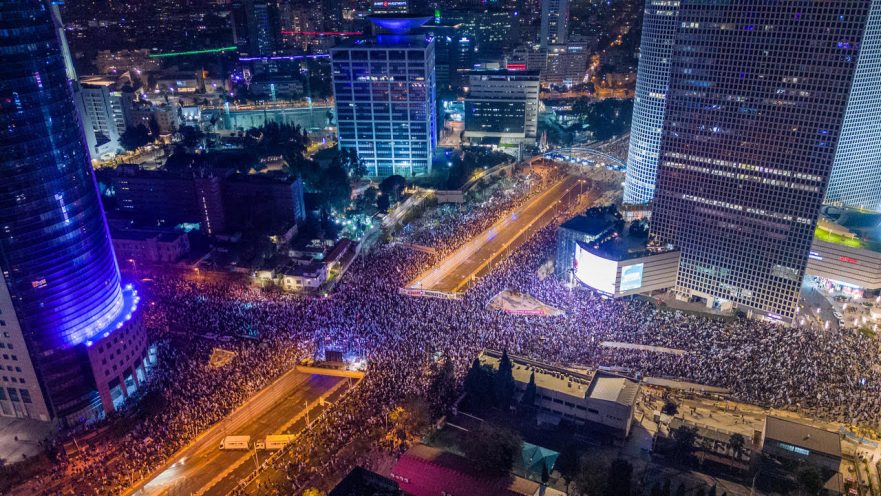by Richard Falk and Stephen Zunes
We are pleased to crosspost an excerpt of this interview with scholar Stephen Zunes and JWE Board Member and International Jurist Richard Falk which was originally published on Truthout.
In this extensive interview for Truthout, international relations scholars and experts Richard Falk and Stephen Zunes break down the intricacies of escalation and latest usages of Israeli force in the Gaza Strip. Over the course of the discussion, they illustrate the historical and political complexity of the situation on the ground. They help to unpack the prospects for civilians, the motivations of Prime Minister Benjamin Netanyahu, and the significance of meaningful investigations. They also make comparisons to previous attacks and invasions on Gazans and talk about where the organized left can potentially help move the needle to impact policy for the future of Palestine.
Daniel Falcone: Just after the August 2022 Gaza escalation, humanitarian groups reported the numbers of the internally displaced people in the five Gazan regions and explained the urgent need for housing in respective areas due to the number of homes destroyed, severely damaged and partially damaged. Can you provide information on what is currently happening on the ground in real time?
Richard Falk: The scandal of denying the civilian population of Gaza construction materials to repair the periodic damage done by air, missile and artillery attacks over the decades of Israeli occupation is an ongoing profound challenge to the conscience of humanity and those who self-righteously claim at the United Nations and elsewhere to be the guardians of international humanitarian law. It should not be forgotten that Israel remains the occupying power in Gaza, and thus subject to the Fourth Geneva Convention governing belligerent occupation. Israel is obliged to comply with international humanitarian law, which among many other relevant prohibitions forbids in Article 33 all forms of collective punishment.
Israel’s claims that its “disengagement” from Gaza in 2005 suspended the relevance of international humanitarian law. To be sure, Israeli troops were withdrawn and its (unlawful) settlements disbanded, but the reality so far as control over the internal life of Gaza is concerned, amounted to nothing more fundamental than a shift in the nature of the Israeli regime of control from direct to indirect, with, if anything, an increased ferocity exhibited toward the more than 2 million civilian Gazans. The 2005 withdrawal of military forces was functionally nothing other than a redeployment of military personnel and weaponry with entrances and exits from Gaza even more tightly controlled than before, and Israeli discretionary violence delivered from the air rather than the ground, except for the massive incursions of 2008-09, 2012 and 2014. The pattern of Israeli rule over the Palestinian population living in Gaza remained what it had been since the occupation began in 1967 — cruel, abusive, unlawful and immoral.
This pattern of control was vividly manifested by Israel’s withholding of construction materials desperately needed to repair residential neighborhoods and essential public services, which were unavailable in Gaza and had to be imported. There was extensive damage to health and school buildings, as well as residential structures which seemed often struck, according to reliable reports, qualifying as distinct violations of international humanitarian law and the more general law of war.
Many construction materials, including 1,000 such basic items as cement and steel, were prohibited from entry by Israel’s preparation of a so-called “dual use” list, enumerating items that were theoretically capable of anti-Israeli uses by Palestinian resistance forces (invariably referred to as “terrorists”). Palestinians, in response, were obliged to take emergency measures to provide housing for the homeless, including the irony of recycling the rubble resulting from Israel’s devastating military attacks with advanced weaponry on a totally vulnerable and mainly impoverished civilian population. Israel made no secret of their intention to keep Gaza on “a subsistence diet” and government advisors in Tel Aviv used ghoulish metaphors to justify the frequent recourse to indiscriminate and excessive force such as the periodic need “to mow the lawn” to keep Gazans preoccupied with their own suffering and deprivations, and so disabled from carrying on their struggle against Israel.
The material deprivations involve all components of what human rights specialists refer to as “basic human needs.” Reliable statistics compiled by the World Bank and UN report an increase of the poverty rate in Gaza to an incredible 65 percent of the population, with no less than 33.7 percent living under conditions of “extreme poverty.” Over 80 percent of Gazans depend on foreign economic assistance, and at least 40 percent are severely food insecure. These conditions have steadily worsened since 2007, when Israel imposed a comprehensive blockade on Gaza (in supposed retaliation for the free elections held a year earlier that produced a surprise victory for Hamas). The blockade has brought the once dynamic economy of the Gaza Strip to a virtual halt, accounting for youth unemployment rate that reached 60 percent. If these cold statistics did not tell of the daily horror story, there are other terrible afflictions, including the availability of very little safe drinkable water and the hazards beyond inconvenience of frequent cuts to electricity.
There are many disturbing reports about Gazans, including of children who need medical treatment not available in Gaza, being denied exit permits by Israeli authorities. As might be expected, these bleak conditions have resulted in widespread psychological trauma, including among virtually all children to some degree, with symptoms including serious depression and epilepsy. Even without these underlying conditions of prolonged captivity, the mental and physical health of the population is kept by Israel far below humane standards. This is confirmed by persistent shortages in specialized treatment and care, medicines, hospital facilities, restorative therapies, aggravated by rigid border controls. To make matters worse, those who suffer from incurable mental illness and serious physical disabilities are confined to live out their lives in an atmosphere of acute anxiety not fit for habitation by even healthy persons.
Against such a background, the passivity of governments and the near silence of the main global media platforms has allowed this fallen state of humanity to persist in Gaza, despite the supposedly special protection of international humanitarian law. The people of Gaza deserve better treatment from the UN which has failed the Palestinian people with respect to their basic right of self-determination ever since its establishment in 1945. Beyond this, the UN with accompanying fanfare affirmed its acceptance of the “responsibility to protect” norm in 2005 as guidance for the fulfillment of its humanitarian responsibilities, in reaction to the UN being circumvented by the North Atlantic Treaty Organization in the Kosovo War of 1999 that was justified as an instance of “humanitarian intervention.” Responsibility to protect was supposedly an adaptation of such interventions to the state-centric realities of the post-colonial world, shifting the locus of responsibility from intervening governments to the organized world community, as I document in my 2014 book Humanitarian Intervention and Legitimacy Wars.
As far as occupied Palestine is concerned, there is no “world community” when it comes to addressing the long ordeal of Israel’s quasi-annexationist “occupation,” only a narrative featuring the grim machinations of geopolitics. The UN and state-centric world order have failed the Palestinians, most notoriously the Gazans, for far too long. The only hope for humane living conditions so long as Gaza remains occupied is through a mixture of Palestinian resistance and more strongly supported civil society initiatives, including censure, boycotts, embargoes and sanctions.
It should also have been taken into public account that Hamas, after its 2006 election victory, several times offered Israel a long-term ceasefire to be negotiated with the declared intention of producing a detailed agreement. Hamas even appealed to the good offices of the United States to promote a ceasefire as preferable to violent confrontation, but neither Tel Aviv nor Washington saw fit even to acknowledge the offer, much less reply.
Stephen Zunes: As with previous clashes, the recent Israeli bombing campaign killed more Palestinian civilians than militant activists. In addition to several children, the dead civilians included Jamal Khuswan, former chief executive of Al-Wafa Rehabilitation Hospital and a leader of the Gaza Dentists Association, his wife, Mervat, and their 21-year-old son Youssef, a medical student. They were killed in their apartment in the middle of the night while sleeping. None of them were involved in militant organizations.
Israel’s violation of the initial Egyptian-brokered ceasefire and its disruption of subsequent ceasefire talks appears to indicate that the Israeli government was not interested in “restoring calm,” but escalating the conflict, knowing that the U.S. will continue to support them and block the UN from taking any action to stop the fighting.
Meanwhile, the destruction of apartment blocks and other civilian infrastructure, combined with the blockade of the ports and border crossings have made it extremely difficult to rebuild, exacerbating Gaza’s ongoing humanitarian crisis.
As when the U.S. government has backed repressive governments in Latin America, Africa, Southeast Asia, and elsewhere, Washington has gone to great lengths to deny or defend war crimes by its right-wing allies and attack human rights investigators for documenting war crimes. Currently, in Washington, politicians of both parties quite correctly condemned the rocket attacks by Islamic Jihad into civilian-populated areas in Israel yet failed to mention, or even defended, the far more deadly Israeli attacks in civilian-populated areas in Gaza. Indeed, President Joe Biden’s policies in the Middle East are remarkably similar to former President Ronald Reagan’s policies in Latin America — supporting repressive right-wing governments and then accusing human rights activists opposing such policies of backing extremists.
Continue reading here.

